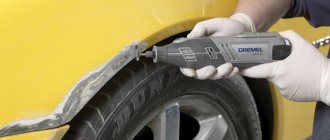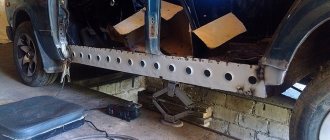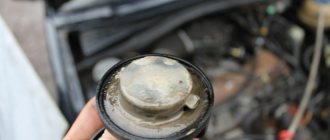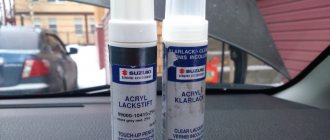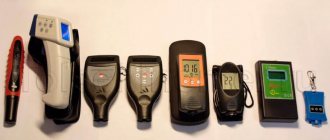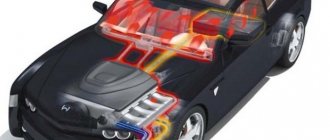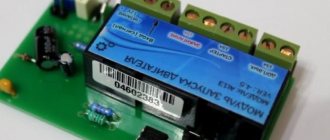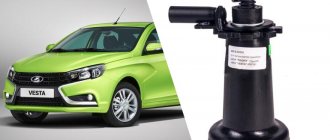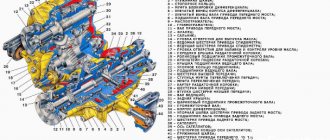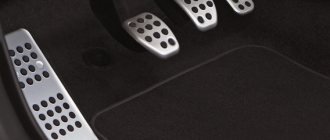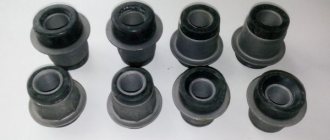Movil with a rust converter - aerosol and liquid, is used to preserve hidden cavities in the car body. Its purpose is to transform existing rust and prevent the formation of new ones. This is just one of the anticorrosion agents, but it is one of the first to be produced in Russia, therefore it is best known to car enthusiasts.
Initially, the formula of this product was developed by the Moscow and Vilnius Research Institutes, which was reflected in the name. Today, this formula has been improved and various ingredients have been introduced into the composition that improve anti-corrosion properties, including rust converters. Anticorrosion agents in Movil, the name of which is indicated “with a rust converter,” are produced by several Russian companies.
What is "Movil"
"Movil" is an anti-corrosion agent that can stop the spread of rust and protect the part from damage. It was created back in the 70s of the last century by scientists from Moscow and Vilnius, during the period when the assembly of the Italian FIAT model began on the basis of the domestic VAZ.
The Italians always treated car body parts with anti-corrosion agents, but the Soviet plant did not have such compounds in its arsenal.
Initially, the product was purchased in Sweden, but VAZ management considered such costs inappropriate, and set the task for its specialists to develop an analogue, but with a cheaper and simpler composition. This is how Movil appeared in the arsenal of the Soviet automobile industry.
The domestic development was made on the same basis as a product from Sweden called Tectyl-390, but the original formula was modified, and very successfully. “Movil” was superior to the original in many respects; it began to be used not only in the USSR, but also in many European countries.
Precautions during use
When working, you should follow the following safety rules:
- The treatment must be carried out in a well-ventilated area. Movil contains substances whose vapors can be poisoned if inhaled.
- You need to work in protective clothing, glasses and gloves. If liquid gets on your skin, you must immediately wash it with white alcohol (Stoddart's solvent, Nefras-S4-155/200) or water.
- To prevent poisoning by volatile substances, it is not recommended to use a car product for 3 days after the procedure. Movil takes a long time to dry.
- The material should be stored out of the reach of children, in a closed container and at a temperature no higher than 25 degrees and no lower than 0.
From experienced motorists you can often hear the expression “you need to treat the bottom with Movil.” Many of them sit in the garage for hours and carry out some manipulations with this product, or “movil”, simply put. Is it really that good?! Or are these simply remnants of the socialist era, in which there were simply no other types of anticorrosion agents. It's time to dot the i's and clarify this issue.
The modern motorist has
Many different types of anticorrosives were taken. The most common of them are anti-gravel, very widely represented by Hi-Gear and Body. As a rule, these are aerosol cans with a high cost. Some of them contain rubber to enhance the protective functions of the composition.
The next type is mastics. These are paste-like compositions that are also used to treat the body in order to protect it from corrosion by covering up the cracks that have formed.
The third on the list will be Movil. This is a composition for anti-corrosion treatment that includes motor oil, drying oil and additives. A product with a different composition cannot be called Movil.
You cannot process an element with Auto Movil and forget it. Unfortunately, over time, Movil is washed away.
Historical reference
Movil received its original name thanks to the developers. This type of anti-corrosion product was created by two interacting research institutes
in the middle of the last century. One of them is located in Moscow, and the other in Vilnius. It was after the first letters of the names of these cities that this preservative was named.
Composition of Movil
"Movil" is a film-forming agent, classified as an inhibitor, based on petroleum products or petroleum-containing products. After applying Movil to a rust-affected area of a body part, penetrant inhibitors penetrate the micropores of iron oxide, transform them into a non-corrosive form, and a durable film of resins is formed on the surface of the area.
This effect is achieved thanks to the thoughtful composition of the product. It includes:
- motor oil and drying oil,
- kerosene and solvent (white spirit),
- inhibitors and zinc,
- rust converters.
Not all formulations include transformative substances. When purchasing Movil, you should give preference to those options that have o or “with converter” on the packaging.
Most people use tannins as a converter - hydrolyzed or condensed substances that can retain and bind other components of the composition. After contact with iron oxide, tannins are converted into water-resistant tannates, which greatly increases the effectiveness of the Movil anti-corrosion agent.
Varieties
Now there are seven main types of rust converters (RC). I will try to talk about them briefly and clearly.
- Simple PR. These are mixtures that contain only one main active ingredient. By reacting with rusted areas of metal, connections are created and corrosion does not spread further. These are drugs based on orthophosphoric acid. Please note that after application, any residue must be washed off. What to wash it off with, you ask? Yes, with regular water. But it's better than distilled. The acid that does not bind to rust will only speed up the process of the appearance of new traces of corrosion;
- Converters to soil with zinc. They do not have the disadvantages of their predecessor, and the composition is distinguished by the additional presence of zinc oxide. This allows all the acid to react. Although, besides zinc, there may be other additives here. A prerequisite for using simple PR and a composition with zinc is a primer before painting;
- Primer converters. Compositions that create a protective film and a primer layer, which allows you to apply a layer of paint immediately after treatment. A special component (Ethyl silicate 32, for those interested) provides water-repellent properties;
- Impregnations that slow down corrosion. Mixtures with an inhibitory effect. Simple and therefore very common. The basis is a paint and varnish material, to which inhibitor additives have been added to help slow down the process of rust formation. They penetrate corrosion and create a durable protective film;
- Neutral. These are those PRs that contain tannin. Another name is acid-free. The interaction of tannin and rust forms a compound that is resistant to corrosion. This allows you to stop the destructive process. But they are not used for cars;
- PINS first generation. These are film-forming inhibited petroleum mixtures. They consist of resins, inhibitors, additives, and solvents. Resin is needed to create protective films. But they are quite soft and elastic;
- PINS second generation. Here organic solvents were replaced with water. In some formulations completely, and in others partially. They have excellent anti-corrosion capabilities, and increased strength protects against mechanical damage. To increase strength, the composition includes graphite powder and zinc.
You roughly understand how a converter works, how an acid-free converter differs from an acid converter. But still I just want to go and choose the best one for myself. To be honest, the question is difficult. There are no universal converters that can be recommended to everyone. The purchase should be approached individually. Moscow, Minsk, St. Petersburg, and a number of other cities offer many stores where you can go and see the assortment.
Be sure to read the reviews and study the video. This will additionally help you make a choice before using one or another composition and applying it yourself.
A little about the manufacturers
Knowing the article number of the product, it is easy to download it via the Internet. But I still advise you to study the product live. Ask for a certificate of quality in stores, since many fakes are now being produced.
Among the manufacturers of converters after which the car body is painted, car owners themselves identify several.
- Docker. The composition includes zinc, which allows for a procedure similar to galvanizing. Quality for adequate money;
- Chemist. Very large selection and reasonable prices. But only a few types of Chemist are suitable for adding to the soil. Instructions for use must be studied;
- Feno. Also a foreign product, reminiscent of the properties of Khimik. But the price is higher. If you want to process the body simply and quickly, choose it;
- Permatex. It has not yet received due popularity, but there are prospects if the quality remains the same. Attracts with its simplicity and speed of processing.
But the list is far from complete
I would also advise you to pay attention to:
Even if you choose the most expensive and high-quality product, if you do not follow the application rules, do not expect a miracle. The result of anti-corrosion treatment largely depends on the correctness of the procedure. Therefore, for some it will be easier to use autoclay. But it also has its own nuances. Perhaps we’ll talk about plasticine with a converter separately.
Release forms of Movil and leading manufacturers
On the Russian market, this anti-corrosion agent is available in three forms at once - in the form of an aerosol or paste, in liquid form, sold in canisters with a volume of usually 3 liters.
The easiest way to work with Movil is in the form of an aerosol, but it costs much more than its analogues. For a bottle with a volume of 250 to 300 ml you will have to pay from 500 to 700 rubles. You do not need to have special skills or knowledge to treat a rusty area with an aerosol. The only rule is that you need to remove traces of corrosion from the part and always keep the bottle strictly vertical when working.
Liquid Movil, which is sold in cans, costs the least. The container is equipped with a special attachment that makes work easier. 3 liters of the product will cost no more than 450 rubles, depending on the pricing policy of the retail outlet and the starting price in the form of a paste sold in plastic or tin cans with a volume of 850 mg. It will cost from 200 to 300 rubles. In order to work with the paste, you will need to dilute it in the proportions recommended by the manufacturer with a solvent, usually white spirit.
In their reviews of the Movil product, both professionals and car enthusiasts note the products of such domestic companies as Agat-Avto, Astrokhim and Razvitie PKF.
Classification of Movils by physical condition
This classification involves division into several types:
- spray;
- liquid;
- paste.
The spray or aerosol is supplied in 500 milliliter cans. One can will cost 4-5 dollars and will be very useful for covering the sills and arches of a problematic body. Basically, the cylinder is equipped with an additional tube, which will help when covering hard-to-reach surfaces. If you don’t have a straw, you’ll have to get a gun or spray bottle, but the gun can only spray liquid substances.
The liquid is supplied in cans. A container with Movil with a volume of 3 liters will cost 6-7 dollars. Using liquid Movil is much easier than using a spray. You will need to get a brush or even a sponge with which you can apply the anti-corrosion material.
When used, liquid Movil is poured into a pistol or another container, but with a wider neck. The remaining preservative is poured into the canister. The liquid product has sufficient viscosity, so it is also useful when treating hard-to-reach surfaces, as well as the bottom. The liquid preservative has no significant disadvantages.
Movil paste is distributed in metal or plastic jars. The average cost of an 800 gram jar is about $4. The area of use for the paste is the same as for the liquid. The paste has a higher viscosity, so it must be diluted with solvent 646 - this is done right before processing.
The paste can be used to treat any body surface (arches, sills, pillars), since it also does not have any significant drawbacks.
Scope of application of anti-corrosion agent "Movil"
"Movil" is a kind of preservative that prevents contact of metal parts with moisture and other substances that cause corrosion. You can treat any body parts with this product, but you should carefully avoid getting it on plastic and rubber elements. The scope of Movil is quite wide. The product can be applied to
- body elements or their individual sections,
- welding seams after repair,
- arches and hidden cavities in hard-to-reach places,
- side members and door pockets,
- hood and trunk elements,
- "casings" of headlights, floor coverings and other parts.
Experts recommend processing the entire body, even if only one part has been replaced, and spot welding repairs have been performed.
It is strictly not recommended to treat body parts from the inside of the cabin with Movil. The fact is that it has a specific chemical smell that lasts for quite a long time. Those who cannot tolerate such aromas or those who are allergic to substances included in Movil simply will not be able to use the car.
Repeated anti-corrosion treatment of the car
Repeated anti-corrosion treatment of a car is usually carried out every two years. At the same time, the hood and trunk lids, reinforcements of the engine compartment, trunk and floor on the interior side can be processed less frequently.
Preparing the machine for applying anticorrosion and the processing process itself is as follows:
- Before repeated anti-corrosion treatment, first of all, you need to wash the car thoroughly and clean all drainage holes.
- We advise you to pay special attention to the large number of hidden cavities and pockets - a lot of dirt accumulates in them, which over time leads to corrosion (read more about how to properly wash your car).
- After washing the car, it must be dried, and only then proceed with anti-corrosion treatment.
- Wipe areas of the bottom with damaged, cracked or peeling anti-corrosion material with gasoline and apply a fresh layer of anti-corrosion material.
- Pay special attention to the wing arches and the areas around the perimeter of the fender liners.
If the treatment was carried out irregularly, then in some places (usually on the bottom of the car) the factory anticorrosive agent may be damaged to the metal. This is where red spots appear, which eat through the iron in 2-3 years.
In this case, before applying the anti-corrosion coating, rather labor-intensive work must be carried out to remove rust, which is performed either mechanically (with abrasive skins), or using chemical compounds (rust converters), or electrochemically. We talked in detail about rust removal here.
Areas of the body that have been stripped down to metal must be primed, after which anti-corrosion mastic can be applied.
When choosing a mastic for re-processing the underbody of a car, you should first of all pay attention to its anti-corrosion properties and only then to its mechanical strength.
If you decide to carry out repeated anti-corrosion treatment at a specialized station, then do not forget to first remove the fender liners, otherwise the wheel arches will remain untreated. We also recommend that you read the tips on which car service to choose.
The video below very clearly shows how anti-corrosion treatment is carried out at a branded service station.
How to use Movil
For any form of release of the anti-corrosion agent, the manufacturer includes instructions for its use. It is important to understand that if you simply apply the composition to the area of the body where rust has formed, it will not disappear anywhere. It is necessary to carry out the preparatory work correctly:
- clean the car from dirt and road reagents, dry it thoroughly,
- clean the area with traces of rust - with sandpaper, grinder, grinder or brush,
- rinse the surface again, preferably with a stream of running water, dry it,
- apply the anti-corrosion compound following the attached instructions for its use,
- if necessary, apply one or more layers of Movil.
Important: if several layers of anti-corrosion agent are applied, then each layer must be thoroughly dried, preferably naturally.
Using the same principle, you can treat the entire car body twice a year, after first cleaning and drying the areas where traces of rust have appeared. Such body maintenance will protect its parts from the negative effects of atmospheric phenomena (rain, sun rays), reagents that are scattered along the roads in winter.
The correct way to apply Movil
Few people go to a service station to have their body treated against corrosion. Because it’s expensive, and you don’t know how they’ll do it. Therefore, it is best to protect the body from rust with your own hands. Properly applied coating lasts for several years.
Expensive special equipment is not required to apply Movil. If you take liquid Movil, then you will need a sprayer (for example, the one used to process potatoes). If there is no sprayer, then it can be applied with a brush. Movil must be diluted with a solvent, for example, White Spirit or No. 646 solution.
In order for the applied anticorrosive to serve for a long time and efficiently, you should wait several days after treating the car body. Don't ride it right away.
Safety precautions when working with Movil
"Movil" is an anti-corrosion agent based on chemicals, most of which are dangerous to human health. The need to work indoors requires you to take certain precautions:
- the space should be well ventilated,
- there should be no open fire or hot stoves nearby,
- the floor plane under the machine must be covered, since the product is difficult to remove,
- hands and face must be protected with special clothing - gloves, mask, goggles,
- It is necessary to work with Movil in a high-quality respirator,
- If the product gets on an open area of skin, remove it immediately, and if it gets into the eyes or mucous membranes, consult a doctor.
After treating it with Movil anti-corrosion agent, you can use the car no earlier than three days later. The point is not only that the treated areas must dry, but also the composition - Movil contains volatile chemicals and compounds that are dangerous to the respiratory system of the human body.
Movil with a rust converter - aerosol and liquid, is used to preserve hidden cavities in the car body. Its purpose is to transform existing rust and prevent the formation of new ones. This is just one of the anticorrosion agents, but it is one of the first to be produced in Russia, therefore it is best known to car enthusiasts.
Initially, the formula of this product was developed by the Moscow and Vilnius Research Institutes, which was reflected in the name. Today, this formula has been improved and various ingredients have been introduced into the composition that improve anti-corrosion properties, including rust converters. Anticorrosion agents in Movil, the name of which is indicated “with a rust converter,” are produced by several Russian companies.
Reviews of aerosol Movil
Although Movil in aerosol form is less popular than car preservative in cans, it is often used by car owners. Users leave various reviews about this tool, there are both negative and positive comments.
Dmitriy. I would like to express my opinion about the Movil preservative in an aerosol can; I bought the Eltrans product in order to treat the front subframe, which has many hidden cavities. The bottle comes with a nozzle with a straw, so spraying the liquid is very convenient. Movil spreads well over the surface, creates a layer similar to solid oil, but emits a rather pungent odor. I liked that this composition is good for treating hard-to-reach places, I can’t say anything about the effect yet, I don’t seem to have noticed any rust. In general, I liked the bottle, the advantages are ease of use, fairly economical consumption (a liter bottle was enough for the entire subframe), I didn’t find any disadvantages.
Yuri. I bought Movil with a rust converter (manufactured by Astrokhim), and was fooled by the advertising. I don’t know who this chemistry helps, for me personally it’s complete nonsense. The product does not combat corrosion at all; the spray nozzle becomes clogged almost immediately and cannot be cleaned. I threw the can in the trash, I won’t buy anything like it again.
Alexei. After 2 years of using my car, I decided to treat the engine compartment, underbody and fenders with a preservative before winter; for this I bought Movil BBF. I did the processing myself, did everything according to the instructions, it took me three bottles, and the total cost was less than 400 rubles. I have been using car preservative for two years now, there are no salt deposits or traces of rust on the car. I recommend this product because it is inexpensive, easy to apply, and gives the desired effect.
Leonid. I have been working with Movil for a long time, since 1998, only then it was sold in a bottle, and I applied it with a brush. Recently I have been using BBF, although the packaging says that it is an anticorrosive agent for hidden cavities, I treat it on my car 2108 and external surfaces, and carry out preventive maintenance before winter. The opinion about the autopreservative is positive; it works effectively, especially since it costs much less than its foreign analogues.
When using Movil, it should be taken into account that the product does not adhere well to mastic, corrodes rubber parts, and is a fairly toxic substance. And you should not apply an anti-corrosion compound to a rusty metal surface; the metal under the anti-corrosion layer will continue to rot. In general, this product quite effectively protects the car body from premature corrosion and does not allow new rust to appear under the protective coating layer.
Composition and principle of action of Movil
Movil with a converter belongs to PINS - film-forming inhibited petroleum compositions. Its action is that, thanks to penetrant inhibitors, the product penetrates into the micropores of iron oxide, the converter transforms the oxides into a non-corrosive form of iron, and polymer resins form a film on the surface. The film blocks the access of water and oxygen, making further oxidation process impossible.
This anticorrosive contains the following substances:
- drying oil;
- engine oil;
- White Spirit;
- kerosene;
- rust converter;
- inhibitors.
What kind of converter is included in Movil depends on AGAT-AUTO; tannin is used as a converter, transforming residual oxides into iron tannate.
Classification of Movils by chemical composition
In addition to the classic Movil formula, some manufacturers try to add something of their own in the form of one additive or another. This somewhat changes the properties of the anticorrosive, but also significantly affects the cost of the coating. The following compositions are distinguished:
- regular Movil without additives;
- composition with added zinc;
- composition with the addition of corrosion converters.
We will not consider the usual Movil, but will pay more attention to its modifications.
Zinc Movil is distinguished by the fact that before its use there is no need to remove corrosion - the damaged areas are immediately treated with Movil containing zinc, which will remain after the coating is applied. The zinc coating will significantly increase the service life of body elements, since it will create auxiliary protection while the car is moving.
The corrosion converter contained in Movil independently eats away rust, so you won’t need sandpaper or a grinder before processing.
Advantages of modified Movils:
- it will take less time to process surfaces;
- less financial costs;
- less labor-intensive to work with.
The only drawback of the modifications is their higher cost.
Manufacturers
Today, Movils with rust converter from the following manufacturers are on sale:
- "Eltrans" - aerosol with a rust converter;
- "Astrokhim" - "Movil Antiruster", an aerosol with a rust converter;
- “AGAT-AUTO” – “Car preservative “Movil””, aerosol with a rust converter;
- “Development of PKF” - “Movil NN MasterWax with rust converter”, liquid and aerosol.
Quite good reviews about the anticorrosive agent produced by Eltrans. It has a memorable design: the bottles depict a medieval knight. They also speak well of Movil NN MasterWax produced by PKF Razvitie.
Processing thresholds with Movil
Zincar rust converter
Threshold treatment must be carried out both to prevent corrosion of a new car, and for a car that has been maintained when this body element is replaced.
Treatment of car thresholds with Movil
Treating thresholds with Movil is a rather labor-intensive task; partial disassembly of the interior cannot be done without it. It is especially difficult to remove plastic parts on foreign cars; with VAZs and ZAZs it is much easier.
So, you start removing all the sill trims: usually they are either snap-on or clip-on
It is important to do everything slowly and carefully - if you break the latches, then when the car is moving, the plastic will subsequently rattle, and the ride comfort in the cabin will decrease
Having removed all the plastic, you should unscrew the sound insulation from the thresholds and find special holes for treating with lubricant. You can also use an alternative method - drilling holes along the outside of the thresholds. Lazy people do this so as not to carry out all the disassembly steps (or if for some reason there are no special holes), but it is undesirable.
Processing thresholds with Movil
For processing thresholds, only Movil in a can is ideal; we put an adapter in the form of a proboscis with a tip on it and insert the nozzle into the opening of the threshold. By pressing the sprayer, we fill the walls of the thresholds with liquid: it is advisable to use a third of the can, or even half, for one threshold. If you were lazy and used the second processing option with drilling, then after processing the holes you definitely need to cover them with something. Often, rubber inserts are used for this, which can be purchased at construction or auto stores.
Hole inserts
For more information about processing thresholds with Movil, watch the video:
Which Movil is cheaper?
Today, Movil aerosols, which contain a rust converter, are in approximately the same price range - about 300 rubles per liter. The final price may vary depending on the region where auto chemicals are sold and the amount of anticorrosive agent purchased. Traditionally, products in small packages are a little more expensive.
Liquid products cost about half as much as aerosols (about 150 rubles per liter). If you plan to apply the product to the surface to be protected using a brush, then there is an opportunity to save money. The liquid can also be applied with a sprayer.
Use of Movil aerosol
Anti-corrosion composition in cans has its advantages:
- due to the small size of the bottle, access to almost any body surface is provided; for treating hard-to-reach places, the bottle is equipped with a special nozzle-tube;
- to work with the spray you do not need special equipment and a compressor; the work can be done in almost any conditions;
- As a rule, such a product does not have such a strong odor;
- The car can be used within a few hours after applying the anticorrosive agent.
But aerosols are also not without their disadvantages, and the disadvantages are quite significant:
- The composition is not used as economically, resulting in a less even layer;
- It takes longer to process large areas of the body;
- chemical spray is more expensive.
Using a spray bottle is convenient for treating small surfaces, for example, a welding seam; before use, the bottle with aerosol liquid must be shaken several times.
What surfaces is Movil anticorrosive agent intended for?
Anticorrosive agent with a rust converter can be used on metal surfaces, including those coated with paints and varnish. Do not coat rubber parts or any surfaces coated with synthetic mastics or other synthetic chemicals with this product.
Car owners use Movil mainly for treating closed cavities - sills, pillars, surfaces behind the radiator trim. Using it to protect the bottom and external parts is impractical, since it does not have mechanical strength. You should not use this anticorrosive agent inside the car, as it has a more pronounced chemical smell than regular Movil.
Types of Movils
Movil can be classified according to several criteria. The first of them is the physical state of the anticorrosion agent. How to use Movil for cars primarily depends on this feature. The physical condition also determines how long the composition takes to dry and its price.
- Movil aerosol.
This type of composition is sold in cylinders. The average volume of a cylinder is 520 ml, the average price of Movil in a cylinder is 250 rubles. The product in cylinders is convenient for treating small surfaces, such as thresholds. Another advantage is that the can often comes with a special long tube designed specifically for treating hidden cavities. If there is no such tube, then you will have to use a special washing machine, but the composition must then be in a liquid state, and more on that later.
The disadvantage of the aerosol is that the container must always be kept in an upright position. This rule becomes especially relevant at the moment when the amount of the composition reaches the middle. Other nuances of use are described in detail in the instructions located on the label of the specific product.
- Liquid composition.
Liquid anticorrosive agent is sold in cans. As a rule, there are canisters of 1.3 or 5 liters. You can buy a 3-liter canister at an average cost of about 350 rubles. This type of product is very easy to use. In order to apply it, you will need a brush or any other available material suitable for this work (for example, a sponge).
For ease of use, the auto-preservative is poured from the canister into containers with a wide neck or a spray gun. Unused product can be poured back into the canister. The density of the liquid aggregate state makes this Movil ideal for processing hidden cavities (this is where the Movil machine comes in handy) and for large surfaces, for example, arches or the bottom. The liquid product has no obvious disadvantages.
- Pasty substance.
This type of anticorrosive agent is sold in plastic or tin cans. The volume can be very varied and depend on the manufacturer. On sale there are containers with volumes of 500 g, 800 g, 2.1 kg and so on. The average price for a package of Movil weighing 800 g is 200 rubles.
The range of application of the composition is the same as that of the liquid one. The fact is that the consistency can be easily changed if you dilute the original composition with white spirit or 646 solvent to the desired state. You can dilute the autopreservative immediately before application. This will not affect its properties in any way. Accordingly, pasty (or liquid obtained from it) Movil is suitable for processing side members, sills, arches, pillars and headlight housings.
Classification by composition
Having understood the consistency of Movil, you can move on to its classification by composition.
Each manufacturer tries to appear original and add their own additives to the classic recipe. Often, the composition of the product changes slightly - and from Movil it turns into know-how at an incredible price. Three types remain the fundamental and most common.
- The composition is without any additives, just a classic anticorrosive agent.
- Movil with rust converter.
- With zinc.
Now we need to look in more detail at the last two.
Movil with a rust converter differs from others in that before applying it you do not need to use a separate composition to remove rust.
Movil with zinc, similar to the previous type, can be applied directly to rust without pre-treatment with a converter. A distinctive feature of such a product will be additional protection during further operation of the car due to the content of zinc, which remains on the surfaces of body elements even after treatment.
Movil with zinc perfectly protects against salt and other reagents that are ready to simply corrode the paintwork of your “swallow”.
The advantages of the last two compositions are undeniable:
- saving time,
- saving labor costs,
- saving financial costs.
There is only one drawback - the cost of a preservative with a rust converter or with zinc will be slightly higher than the classic version.
Instructions for use
Movil is applied to easily accessible places as follows.
- Surface preparation: dirt and rust (the top loose layer of oxides) are removed from the metal, after which it is degreased.
- Drying the surface.
- Applying the 1st layer of Movil (the temperature should be within +10° C to +30° C). The spray is applied through the spray head, and the spout and tube are removable (they are designed for hard-to-reach areas). The liquid is applied with a roller or brush.
- Intermediate drying. If necessary, it can be accelerated by pouring warm air over the treatment area.
- Applying the second and third layers (with another intermediate drying).
- Final drying. The final drying of the composition occurs approximately two hours after applying the last layer.
If during processing the product gets on the front surface, you need to immediately wipe it with a bitumen stain cleaner.
Car body preparation
Usually, the parts of the car body that rot the most from corrosion are the bottom and wings. The bottom of the vehicle is destroyed faster in areas near the sea, that is, with high humidity. And if salt or reagents get on the body, then in general the destruction of the metal occurs much faster.
Which parts of the body should be treated with anti-rust and anti-corrosion:
- spars;
- door sills;
- floor;
- bottom;
- central pillars;
- headlight housings;
- arches of the front and rear wings.
First, thoroughly wash the surfaces to be treated. If you have a mini sink, for example, a Karcher, then select the appropriate nozzle and use a stream of water to beat off the dirt. After that, wait for it to dry completely. If the weather is rainy at this time, you can dry it in the garage with a compressor.
How to treat hidden cavities?
The processing of hidden cavities has its own characteristics.
- It is necessary to remove those elements that prevent access to the surfaces being treated.
- Rinse the cavities with water through the drainage holes. Before washing, check and clean the holes if necessary.
- Treat the cavity with a rust converter, then rinse with an alkaline reagent. The reagent is selected depending on the type of converter.
- Dry the cavity with warm air.
- Apply layers of anticorrosion with intermediate drying.
Sprayers with a working pressure of 4-12 MPa (airless application) or 2-4 atmospheres (air method) are suitable for applying liquid.
Features of using Movil
Treatment of hidden body cavities with Movil is carried out in several stages and requires compliance with certain rules.
Surface preparation
Before starting application, the surface must be cleaned of dirt and loose corrosion.
- Remove oil deposits and dirt by washing with car shampoo.
- The car is allowed to dry for several hours.
- The surface is cleaned of peeling varnish and paint, swollen rust, degreased and dried again.
Before starting work, it is recommended to protect the paintwork, rubber and plastic parts with thick paper or polyethylene, securing them around the perimeter with electrical tape.
Dilution of the composition
Solvent or white spirit speed up the drying of the product after application, but it is not always recommended to dilute Movil with them. You can add a solvent to a liquid product, but this increases its fluidity, thereby reducing the strength of the film. Dilution of the aerosol autopreservative is not provided.
The most difficult thing to apply is paste-like compositions, because they become very thick. But experts advise not to dilute them before work, but to carefully heat them in a water bath until they liquefy slightly.
Applying Movil to problem areas
Areas of the body are treated with Movil in 2-3 layers, evenly distributing it over the surface with a brush or spray. Each layer is dried for at least 20 minutes, but the exact time interval is indicated in the instructions. Cracks, crevices and other hard-to-reach areas are filled using a bottle with a flexible tube.
The first anti-corrosion treatment with Movil is carried out on the door or trunk. This will show how the composition is distributed and spreads, and will allow you to evaluate the consumption of the product and the convenient method of application.
If Movil accidentally gets on the top paintwork or tires, immediately remove it with solvent or gasoline using a rag or sponge.
After anticorrosive treatment, it is recommended to operate the vehicle no earlier than 3-4 days later.
Drying time
How long Movil takes to dry depends on the ambient temperature. :
- 2 hours at +18…+23 °C;
- 3-5 hours at +10…+16 °C;
- up to 1.5 hours at +25…+30 °C.
During this time, the autopreservative turns into a thick, dense film. It takes about 2 weeks for final hardening. The thickening process slows down with increased air humidity. Movil takes a long time to dry at temperatures below +10°C. Other factors influencing the drying speed are the concentration and degree of volatility of the solvent in the product: the higher they are, the faster the composition hardens.
Precautions when working with the composition
It is advisable to apply Movil outdoors at a temperature not lower than +23°C. If work is carried out in a box or garage, then maximum ventilation must be ensured.
Movil must not come into contact with plastic and rubber parts (tires, hubcaps, etc.) or visible paintwork, since after drying the product will be difficult to remove without damaging the surface.
During operation, observe fire safety measures: do not smoke, do not use heating devices or open flame sources.
Movil contains flammable substances.
How to wash the composition from surfaces
On body parts, Movil eventually turns into a dense film. It's not easy to remove. According to reviews, gasoline washes only part of the layer. Aviation kerosene is more effective in this regard: they need to soak the Movil for 1-2 hours, and then wash off the composition with warm water and car shampoo, liquid soap or dishwashing detergent.
Another cleaning option is to heat the surface with a hairdryer, and then remove the still warm anticorrosive agent with a hard sponge or rag soaked in white spirit. Among other available means, isopropyl alcohol is effective. You can also use a solution of laundry soap shavings in turpentine (1:1).
A remover for bitumen stains (AiS Asbright Spotooff, ELTRANS, Astrokhim AC-395, 3TON, SHIMA, LAVR Antibitum, LIQUI MOLY Teerentferner, etc.) and WD-40 lubricant also wash Movil from the surface of the body quite well, but for cleaning they require great effort.
Precautions during operation
Do not allow the product to come into contact with unprotected areas of the body. Movil should be applied either outdoors or in a well-ventilated area. If the product does get on the skin, you need to wash it off with white spirit. Anticorrosive is a flammable material, so you should not smoke while applying it.
During storage and transportation, it should be taken into account that exposure to direct sunlight and heating above + 50º C, as well as being near sources of open fire, is unacceptable. In aerosol cans, the product is under pressure, so the temperature of transportation and storage should be even lower - up to + 40º C. Another safety measure is to store auto chemicals in places inaccessible to children.
Do-it-yourself anticorrosive protection of the bottom and sills
Before starting to treat the sills and underbody of the car with a protective agent, you must:
- thoroughly clean the surface to be treated from dust and dirt, blow with compressed air;
- before blowing, it is necessary to remove all rubber plugs in order to gain access to the technological holes and blow out all the dirt from the inside;
- degrease the external body parts (optional, but recommended);
- heat Movil to a temperature of 50-60 degrees Celsius, dilute it with white spirit (for 2 kilograms of anticorrosive agent you need 0.2 liters of white spirit).
To fill the thresholds with an anti-corrosion compound, you must use a powerful compressor and a spray bottle with a “tube” nozzle. All hidden cavities are filled with Movil under pressure, then an even layer of anti-corrosion agent is applied to the surface of the bottom from above.
When treating with anticorrosive agent yourself, it should be taken into account that the preservative emits a very unpleasant odor, so it is strongly recommended to work in a respirator. Odorless Movil is practically never found (if you do not take into account imported aerosols in bottles), so you need to be prepared that the unpleasant spirit will dissipate for quite a long time.
You can pour Movil into the thresholds without using a spray bottle; in this case, you will need a funnel and a piece of rubber hose mounted in one structure. The cavities are filled with an anti-corrosion compound from above; often to carry out such work it is necessary to dismantle the floor in the cabin.
On the outside, anticorrosive coating is applied in two or three layers, the normal ambient temperature for treatment is about +20°C. Each layer must be allowed to dry for one and a half to two hours; on average, approximately 400 g of Movil is spent per square meter of treated surface. After drying, the anti-corrosion agent practically does not smell, does not get dirty, and acquires a brown tint.
Myths and facts
There are many rumors about Movil among car owners. Some of them turn anticorrosive into an extraordinary miracle remedy, while others, on the contrary, deny all the positive aspects. It is worth sorting out the fables in order to use the product for its intended purpose and get the expected effect as a result.
Movil with a converter can be applied to metal with any layer of rust - the chemical will “eat” everything. In fact, the loose layer of oxides must be cleaned off. The converter only copes with the residual layer, which is difficult to remove from the metal. That is, using such a product, the metal does not need to be cleaned until it shines, but the “growths” of rust and dirt need to be removed.
Aerosol consumption is less than liquid. In reality, both the liquid and the spray should form a uniform, thin layer on the metal. In both cases, the consumption will be approximately 400-500 ml per square meter.
Movil, produced in Soviet times, was real, but now they sell compounds that are much worse. In reality, only counterfeit products can be worse in quality, since official manufacturers are interested in good reviews and increasing sales of their products, and not in complaints and returns of low-quality chemicals. At the same time, the consistency and appearance of the anti-corrosion agent may differ from its “grandfather”, as manufacturers try to improve qualities such as fluidity during application, resistance to high temperatures, and anti-corrosion properties. Improvement occurs due to new inhibitors and additives, for example a rust converter, so the smell, color, and density of the composition changes.
It is enough to apply the product once when purchasing a car. The opposite, but equally incorrect opinion is that cavities need to be smeared with Movil every month. Those who have used such auto chemicals know that the product will protect the car for several years if hidden cavities have been treated, and will last no more than a year on surfaces exposed to mechanical stress.
Movil, what is it? This question interests many who have encountered corrosion on the car body, and why Movil is needed immediately becomes clear - in order to protect the body from corrosion. Despite the fact that modern cars are well protected from corrosion, this does not mean that rust will not form, since winter driving around the city has a very unfriendly effect on the body’s resistance to corrosion. Movil for cars: we will now find out how to use it.
Therefore, it is advisable to additionally treat the car body with Movil, the method of application of which is not as complicated as it may seem at first. What is Movil for cars? This is simply an indispensable tool for those who love their car and drive it all year round.
Of course, in addition to Movil, there are many other products on the market that are created to improve the anti-corrosion properties of a car. But Movil has proven itself very well, because it is inexpensive, which is why it is so popular in Russia, and its quality is at the level of its foreign analogues. Movil is a substance that prevents metal from coming into contact with the external environment, namely moisture and air. If the metal is not exposed to moisture, then rust will not form.
Video
For those who don't like to read, after watching this video you will know what MOVILLE is?
And this video received several thousand likes for useful advice. How to remove saffron milk caps in 5 minutes.
Improved new mobile in a can.
The bodies of modern cars are able to withstand through corrosion for an average of 5 to 10 years, then gradually the rust begins to “eat up” the body parts, and over time, pockets of rust appear on the bottom and wheel arches. To ensure that the body iron lasts as long as possible, special protective agents are used, in particular, Movil is used to treat the lower part and hidden cavities of the body.
The anti-corrosion coating protects the metal from premature rusting, which occurs as a result of the negative influence of the environment; the metal corrodes due to interaction with water (moisture) and oxygen. Various bitumen mastics and special chemical compositions applied to body iron allow you to extend the life of the metal and delay the next repair.
Movil for cars: how to use it correctly
Movil for cars: how to use it is quite simple to understand - you just need to apply it to arches, hidden cavities, welds, anywhere where moisture can linger. But before applying, you need to carefully treat those places where rust has already appeared. Because even if you apply Movil to a rusty part, the rust will still continue to develop, but more slowly.
But Movil has a rather specific smell, so it’s better not to treat anything with it in the salon. What color is Movil - when it dries it turns dark brown. When using Movil, it is important to thoroughly dry the surface so that there is no moisture there at all, otherwise the moisture will simply remain under the protective layer, and perhaps corrosion will begin to appear under the protective layer, which will not lead to anything good.
When the surface is prepared, you can apply Movil either by spraying or coating, depending on the case, you need to select the correct consistency of Movil using a solvent. If the mixture turns out to be very thick, it may not penetrate into some seams, and it will also lie unevenly. If the mixture turns out to be very liquid, it may not stay on the surface. Also, the consistency depends on the temperature, so it is best to apply Movil in a warm room. If you do work in the heat, the material will become more liquid and the smell will be very pungent, so in the heat you need to add less solvent.
Movil aerosol is available for sale; it has the correct consistency already selected and does not require application devices. In the case of an aerosol, anti-corrosion protection must be done in several layers, because the thickness of one layer is quite small. The durability of this layer is also less, since the spray here is quick-drying.
If hidden cavities are found, they must be treated by extrusion without spraying; for this you can use a special metal tube. The main thing is to achieve an even distribution of Movil.
Let dry
In addition, after Movil has been applied to the body, you must wait at least one day for Movil to thicken. Moreover, there is no need to dry anything additional. It is not necessary to wait until the substance has completely dried, because Movil for cars should not dry out, it simply thickens, becomes elastic, but not dry.
Which parts of the car are recommended to be treated with Movil:
- door pockets,
- arch cavities;
- spars;
- hood and trunk;
- headlight housings;
- floor thresholds;
- body pillars.
But open surfaces that are exposed to the external environment, such as the bottom of a car, do not need to be treated with Movil, since it is better to use an anti-gravel coating for this and provide full anti-corrosion protection.
It is believed that Movil contains a rust converter, so the surface does not need to be pre-treated. But there is not much of this converter there, so it is better to treat the body before using Movil - completely remove the rust, and then apply Movil.
First anti-corrosion treatment of a car
It is best to carry out the first anti-corrosion treatment in a specialized workshop, where experienced craftsmen, in addition to the actual treatment of the car, will also drill all the necessary holes and install the fender liners in their places. But if you wish and have some skill, these operations can be performed with your own hands.
During the first anti-corrosion treatment, it is permissible to use inexpensive materials of domestic production. Movil or similar compositions are most often used as an anticorrosion agent Read more about this in the material: How to treat the underbody of a car?
The most vulnerable places for corrosion are the thresholds, boxes above the jack brackets, cross members and reinforcements on the bottom side, side members and doors closed at the ends - they require especially careful treatment.
Anti-corrosion treatment of the car from the inside occurs through special technological holes, that is, without disassembling the body and doors. The maintenance manual for your car should contain a diagram of anti-corrosion treatment indicating all hidden cavities and how to access them.
Tectyl into these places from an aerosol can, because, unlike similar products, it has a flexible tube with a sprayer, with which it is quite convenient to treat hidden cavities.
At service stations, anticorrosive agents are applied in hidden cavities using airless spraying under a pressure of 6-8 atmospheres. During the supply of the composition, it is mixed with air and a certain mist is formed, after drying it produces a very thin, but at the same time with a high degree of protection, anti-corrosion coating. Moreover, it is completely transparent.
After anti-corrosion treatment, plastic fender liners are usually installed in the wheel arches. But the last “squeak” is the so-called liquid fender liners, which are a viscous paste that is applied directly to the body and, after hardening, turns into a kind of plastic.
Here are a few more tricks and useful tips that will help when carrying out anti-corrosion treatment of your car:
- Particular attention should be paid to the uniformity of mastic application: a layer that is too thin will not be strong enough and will begin to quickly collapse under the impacts of small pebbles, and a layer that is too thick will crack and peel off under the influence of vibration.
- The most optimal thickness of the anti-corrosion coating is approximately one and a half to two millimeters. In this case, the mastic consumption will be about 4-5 kilograms per car.
- Before the first signs of corrosion appear, the mechanical properties of the protective layer are more important than the anti-corrosion properties.
- It would be useful to cover the entire floor from the inside with a layer of BPM-1 anti-noise mastic.
- By removing the rubber plugs at the ends of the thresholds, you can significantly extend the service life of the latter. With the fender liners installed, dirt and debris still do not get into these holes, and through ventilation of the sills while the car is moving will only benefit them.
You can carry out anti-corrosion treatment on your car at any time of the year.
Safety during use
When working with Movil, you need to ensure that there is good ventilation, and remember that Movil contains components that are easily flammable. Also, do not allow Movil to come into contact with the skin or other parts of the body.
It is necessary to ensure that Movil does not come into contact with rubber or plastic parts, because it will have a negative effect on them. You also need to remember that a stain of frozen Movil is difficult to remove later, so you need to apply the substance carefully.
It also happens that excess substances can drain from the car onto the garage floor. Therefore, you can first lay down oilcloth to keep the floor clean.
It is also advisable to check the condition of the car’s anti-corrosion coating every few months. If it is noticed that the Movil has hardened and is no longer elastic, this means that the treatment must be repeated, and the composition must be made more liquid. But the old layer must be removed using a solvent or using a product that removes bitumen stains.
If you follow all the rules and recommendations for using Movil, you can achieve excellent protection of the car body from corrosion for a fairly reasonable price.
And then a video about how you can move a car with your own hands:
Why anti-corrosion treatment of a car is carried out?
All cars, regardless of model, class and operating conditions, are subject to corrosion. Figuratively speaking, from the moment it leaves the production line, every car is haunted by its worst enemy - rust. If proper care is regularly neglected, any car can reach a condition similar to the one in the photo above.
Despite the fact that each manufacturer treats the cars they produce to prevent further aging and rust with a special anti-corrosion mastic (and some parts are even coated with zinc), this is still not enough. Sand flying from under the wheels, working like a sandblast, crushed stone causing chips from falling into holes on the road, and so on - make themselves felt very soon.
The situation gets worse in winter, when the roads are also sprinkled with chemicals. The alkali and salt they contain corrode the iron body parts of cars at an accelerated pace. So anti-corrosion treatment of the body, if you want to preserve and protect your car from corrosion, is really a very important thing.
Of course, a rotten body can be restored, but the cost is comparable to buying a used car. It is the corrosion of the body that determines the service life of the car, so you should not wait for through holes to appear.
The main goal of additional anti-corrosion treatment of a still new car, performed by the owner either with his own hands or at a specialized station, is to preserve the integrity of the factory protective coating for as long as possible.
Even with factory anti-corrosion treatment, additional complete anti-corrosion treatment of the car will not be superfluous, since it is aimed at long-term preservation of the original appearance of the car and the strength of the metal. This procedure takes 3-4 hours if it is performed by qualified specialists using professional equipment.
Experienced professionals advise checking the condition of the machine’s anti-corrosion coating at least once every six months. During repairs or replacement of body parts (for example, after an accident), the anticorrosive agent must be renewed without fail.
When to use?
The best option is advance processing. That is, you shouldn’t wait until your car “blooms.” Therefore, experienced motorists treat the bottom and sills of the car once every 2 years, and those living in large cities before every winter. Otherwise, the body will rot in a few seasons.
Some people treat with Movil after rust has appeared. This is not entirely correct. The fact is that this drug does not remove rust. Its task is to prevent iron from coming into contact with oxygen contained in the air. Thus, the possibility of formation of corrosion centers is eliminated. But, if you apply Movil to an area already damaged by rust, it will not stop the spread of damage. Therefore, we can consider that this substance is rather a preventive measure. The protective film also has excellent water-repellent properties.
Qualities of anticorrosives
“Which anticorrosive agent is better?” - this is the most expected question from the buyer, since it is easy to get confused in such a large number of products presented on store shelves today. There is no universal remedy; it is necessary to adapt to the specifics of the surface. Any high-quality anti-corrosion material must have certain characteristics:
- High resistance to corrosion processes
- Formation of a durable protective layer on the metal surface
- High degree of adhesion (good adhesion to the surface)
- Preventing Corrosion
- Preventing the development of already formed corrosion
- Fire resistance
- Fire and explosion-proof composition
- Non-toxic composition, safe for human health
Nuances when using
Many drivers prefer to take care of their cars themselves. However, you need to understand that the service technicians have experience in using various anti-corrosion agents. An untrained person needs to take into account some details when using Movil independently:
- The car preservative has a specific odor, so it is not recommended to use it for treating metal parts in the interior.
- When applying to open parts of the car (roof, fenders, hood, doors), it is worth remembering that after drying the coating becomes brown.
- The product must be applied to the weld seam. It is necessary to carry out the work very carefully. If it gets on non-metal parts of the car, the latter will most likely be damaged.
- It is necessary to refrain from traveling in your vehicle for several days, as the smell from Movil is not only disgusting, but also dangerous.
- Movil, if necessary, can be diluted with an oxidizing agent.
- It is better to apply in 2-3 layers.
Before using an anti-corrosion substance yourself, it would be a good idea to consult with specialists. In addition, there are a lot of videos on the Internet where masters clearly demonstrate the method of use.
Specifications
How to use Movil for cars? To answer this question you need to understand its features. To begin with, it should be noted that Movil is a preservative. This allows it to be used not only on existing vehicles, but also to protect various metal structures from corrosion. The drug was created back in Soviet times. A combined group of scientists from research institutes in Moscow and Vilnius worked to achieve optimal characteristics.
The composition of the substance is quite complex. In addition to machine oil and drying oil, this includes a variety of inhibitors. It is their presence that explains the possibility of active protection of body parts from corrosion. The material is quite fluid, but with proper application it is possible to create a protective layer of optimal thickness. When purchasing, pay attention to expiration dates. The substance retains its properties for 24 months from the date of production.
